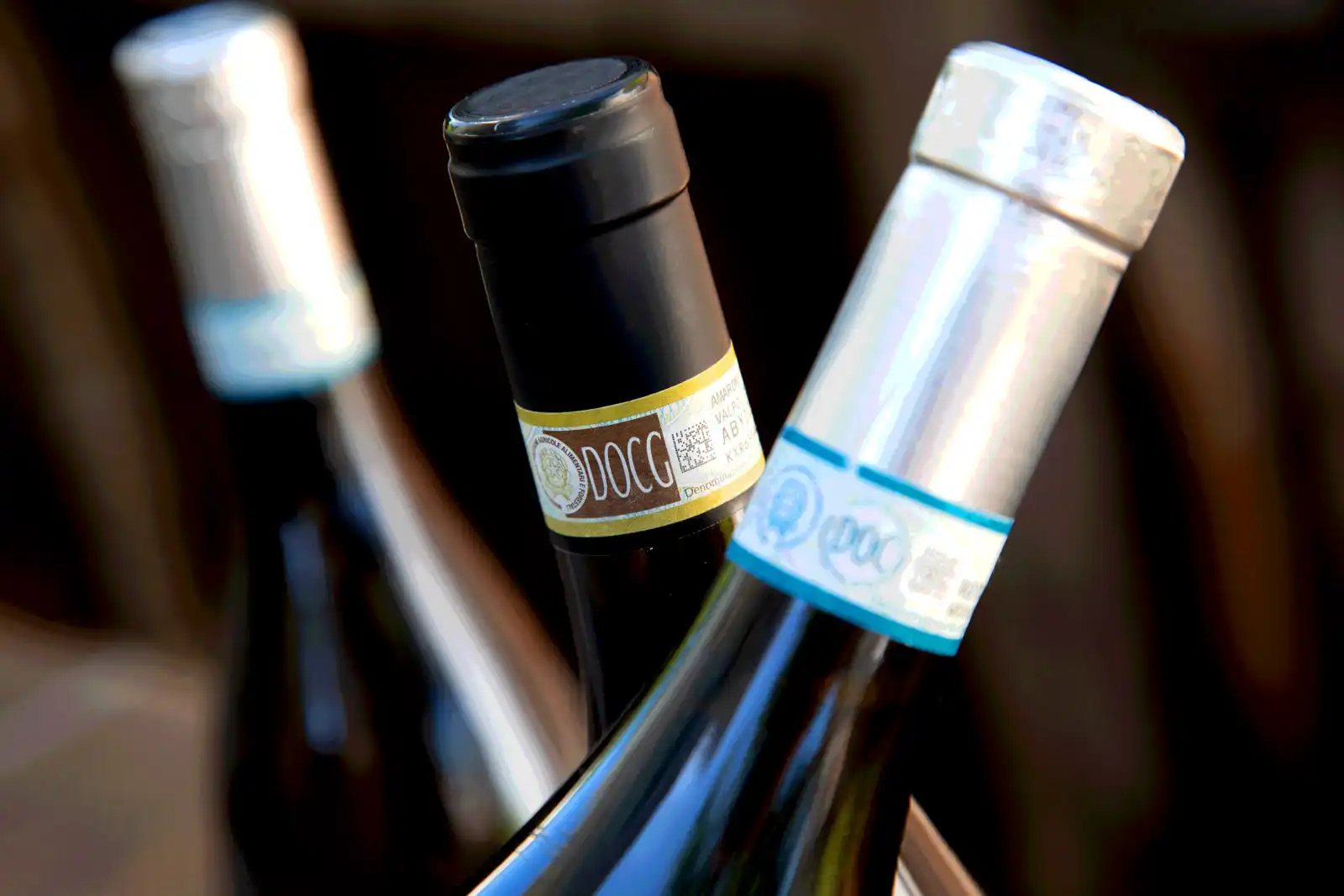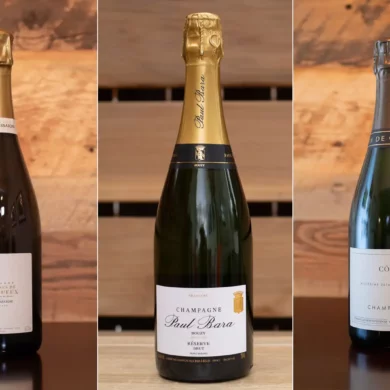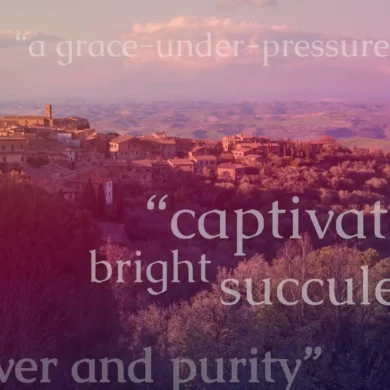It is often the first thing you learn about Italian wine: the difference between DOC and DOCG wines as classified appellations. We’ve been told for decades that the DOCG wines are of superior quality because of the rigorous demands placed upon them, and by extension, that the zones which have earned DOCG status are of the highest quality in Italy.
It is either time to scale back the entire system to only DOCs, or frame the conversation in a more helpful direction.
But anyone who drinks Italian wine regularly knows this is not entirely the case. Not only are there thousands of individual DOCG wines that taste anonymous, there are also thousands of DOC wines that are downright thrilling. (The inverse of that statement is true as well). But more pertinently, many of Italy’s most compelling, thought-provoking and future-equipped winemaking regions are at the DOC level, and some of them have no interest in graduating to the DOCG.
So why do we keep referring to the DOCGs as a function of quality? And if that level is not about quality, then what good is it? Is the category ultimately meaningless? Or does it actually represent something truly helpful that we’ve failed to communicate?
It is either time to scale back the entire system to only DOCs, or frame the conversation in a more helpful direction. Since the former is unlikely, I think the latter is our best bet.
First, Let’s Define DOC and DOCG Wines
The European Union is charged with setting regulations for the wine industries of all EU member nations, and they do this via the Protected Designation of Origin (PDO) program, which was instituted in 1992 and has been tweaked and revised a few times since. The primary principle behind the system is twofold: (a) to guarantee a wine’s origin for the consumer and (b) to protect that region and its producers against imposters and fraud. The same system applies to foods of distinct origin too, covering everything from France’s Comte cheese to Greece’s Kalamata olive oil to Sweden’s Falukorv sausage.
While Italy’s system is older than this EU designation (1963), the model neatly conformed to the EU structure, meaning appellations set forth before 1992 were grandfathered in with little change. The EU system does not require levels of quality to be codified, but it also doesn’t prohibit it. Italy added that additional level — the G in DOCG — way back in 1980. There was an expectation in 2008, when the EU revised the code and pushed for a single level for all products (PDO), that the DOCG would go away, but a wrinkle in the statute allowed it to stay.
The easiest way to spot whether the Italian wine you are drinking is a DOC or DOCG wine is to take a look at the bottle’s neck. If it is a regulated wine of specific origin, then you will find a little collar, known as the fascetta, proclaiming either DOC (with blue trim) or DOCG (with gold trim). See the photo above.
These acronyms stand for Denominazione di Origine Controllata (or a “denomination of controlled origin”) and Denominazione di Origine Controllata e Garantita (a “denomination of controlled origin that is guaranteed”) and they are awarded to specific, delimited zones of wine production. To earn that fascetta, the wine must pass several parameters to qualify for that specific appellation name (such as Montepulciano d’Abruzzo DOC, Chianti Classico DOCG or Taurasi DOCG).
Two other levels exist for more broadly defined wines: the regional IGT (Indicazione Geografica Tipica) and the broadest and most open-ended of all, Table Wine or Vino da Tavola. Neither has a fascetta, but like DOC and DOCG, these designations will be spelled out on the label as well. It is important to note that many of Italy’s most celebrated individual wines — like Gravner’s Ribolla, Foradori’s Granato and Bibi Graetz’s Testamatta — fit into one of these two categories. Many talented producers often opt to work outside the DOC/DOCG system because of the creativity that fewer restrictions afford the winemaker.
How is the DOC/DOCG System Suppose to Work?
So what is that guarantee — the G in DOCG — exactly? Well, it is intended to be a guarantee of quality because of the more stringent requirements baked into DOCG regulations. The philosophy is this: by mandating certain parameters known to produce quality wines, the resulting product’s quality can be guaranteed.
To be promoted to DOCG, an appellation must first be a DOC for 10 years. This is intended to establish brand recognition on the market, as well as a track-record of quality and consistency that can be vetted during the application process for promotion to DOCG.
In the vineyard, DOCG appellations often have more stringent requirements on yield. The idea is that less grapes equals more energy and concentration (therefore quality) in the remaining grapes. Higher planting density and higher potential alcohol are also often factored in.
In the winery, DOCG status often has additional parameters that are intended to create a finer wine. Again, higher potential alcohol thresholds, longer aging requirements, sometimes longer exposure to oak, and the need to bottle the wine within the production zone to ensure quality.
The other major difference on paper between DOC and DOCG wines is the addition of a blind-tasting panel to prove “typicity,” and a laboratory analysis to ensure the wine achieves certain chemical and organoleptic parameters.
The outcome of all of this is that making a DOCG-level wine is serious business. The standards are higher, and therefore, the wine should be better. And if the wine is better, than it naturally will become more prestigious over time. And with prestige, comes higher prices.
So What’s the Problem?
To quote Syndrome in 2004’s The Incredibles, “when everyone is super, no one will be.”
The problem is two-fold, but it starts with consumers and our relationship to them.
Wine is ridiculously multifaceted and complex, especially in Italy. Making sense of an entire ecosystem of wines is no easy chore, especially if you are in the business of selling it to people who want easy answers and have open wallets.
From the beginning, the wine industry has used classification systems to make sense of what nature provides winemakers. Perhaps most famously, we have the 1855 classification in Bordeaux and the Grand Cru vineyard rankings in Bourgogne. But even back in ancient Rome there were attempts to categorize vineyards based on quality, including Pliny the Elder’s ranking of “first growths” of the Republic.
Today, in Italy, the closest we have are the DOCG appellations.
Dumbing Down Discourse
The knee-jerk reaction for consumers is to say “I only want the finest,” and so the DOCG appellations become an easy starting point for merchants, sommeliers and wine educators looking to bring newcomers up to speed. But from the beginning, we’re oversimplifying the discourse by focusing on this level as a function of quality. After all, what is “quality?” The least potential flaws? The most intensity of flavor? The biggest structure? The longest track-record of age-worthiness? The most versatility with different cuisines? Having studied the standards for years, I know this last question is never factored in.
Furthermore, we are neglecting to educate consumers on the factors that go into making truly compelling wine — factors that are not always baked into the appellation system. We are squarely in the age of climate change, yet nowhere is there talk of revising the standards for DOCG wines to take into account the percentage of vineyards that are farmed organically, biodynamically, sustainably or — most importantly — in support of biodiversity. These traits matter, both from a future-proofing standpoint, but also in terms of quality in the glass.
Poor Implementation
But the biggest problem with the current state of the DOCGs lies in their implementation. A system is only as good as your level of commitment to it, and over the years, the Italian authorities have gotten carried away with the DOCG level, effectively lopping off the top of any quality pyramid they were hoping to build by granting the status to nearly 80 different appellations. To quote Syndrome in 2004’s The Incredibles, “when everyone is super, no one will be.”
Of course, no one involved in Italian wine law would say that their intent is to dumb-down Italian wine. And that’s not my accusation. I think their intention is to raise the profile of Italian wine internationally by having a robust list of DOCGs.
But at this point we need to be brutally frank: the DOCG level as it stands is not helpful to consumers.
If you were to scan the list of DOCGs, you’d notice many of the iconic appellations (and rightly so), but also several appellations that few of us have ever heard of or tasted. More importantly, there are several notable appellations missing. None of my colleagues whom I’ve discussed this with, would call that list the true créme de la créme of Italian wine.
Secondly, losing DOCG status isn’t in the cards for anyone. Once attained, it is not taken away. What good is any classification system if it is iron-clad in a changing world?
Lastly, we have to ask it the criteria for DOCG wines is still relevant. Yes, it is rigorous, but is it the criteria that defines what a new generation of drinkers considers to be “quality?”
Chasing the Wrong Thing
Case in point: I recently visited a winery in Central Italy as part of a press tour. During the tasting with a dozen other journalists, the winemaker proudly unveiled a red wine as part of a new DOCG created for a terroir that none of us had heard of. OK, fine, no problem. We all love a good story-angle on an emerging wine region with excellent promise. Lay it on me.
The wine, however, smelled of cherries, vanilla bean and black licorice. It was highly extracted, alcoholic and loaded with woody tannins. Despite being made from a local grape variety, it was indistinguishable from the millions of Bordeaux-blend imitators that defined quality in the 1990s and 2000s. But terroir? A sense of place? Versatility at the table? Freshness? I wondered how this could have passed any tasting panel with “typicity” as one of its criteria.
When I pressed the producer as to why this new DOCG was created, he very honestly (and proudly) proclaimed that they felt as a community that their wines should sell for more. The wine was bottled in heavy glass accordingly — a cynical marketing tactic that continues to dupe consumers into thinking the wine is more serious — and I recoiled at the short-sightedness of it all. Were they chasing the DOCG so they could make short-term profits with a demographic that is controlling less and less of wine’s future? I need to hear from his contemporaries and taste more from the appellation before calling out this specific DOCG, but it was a startling conversation: the antithesis of sustainability. And I could easily see the scenario being duplicated elsewhere in Italy.
Rays of Hope?
And it saddened me for Italian wine in general, for I love sharing its most iconic wines with the world. The Tuscan village of Montepulciano and its Vino Nobile wines is where I first realized wine’s magical power, and Barolo is where I truly cultivated my inner wine geek. In Valtellina, I felt a profound empathy for heroic viticulture and its protectors, like the Pelizzatti Perego and Fay families. In tiny Rosazzo, I tasted a radiant white blend while experiencing the gravitational pull of 1,000 years of history. And in Cerasuolo di Vittoria, I have come to love the most perfect Thanksgiving wine that few Americans know about.
All five appellations produce DOCG wines. And all five of them represent the best of what this system is intended to preserve: a sense of place via its signature product.
How Should We View DOCG Wines?
We need to change the conversation around these appellations. Rather than a pyramid of quality, the Italian classification system is a pyramid of specificity.
Seen through this lens, the DOC feels essential while the G feels antiquated. It is a vestige of old thinking that status and prestige have a formula that can be followed.
But talk of abolishing an aspect of the system that is this entrenched in the bureaucracy, and that drives this much of the Italian wine industry, is utterly fruitless.
Instead, I think we — meaning independent consumers, educators, journalists, and sommeliers — need to change the conversation around these appellations.
Rather than a pyramid of quality, the Italian classification system is a pyramid of specificity.
DOCGs are fewer in volume, and the nature of their regulations calls for a more specific, focused wine. That we can be certain of.
Meanwhile, the best DOCs are compelling not because of how restricted they are, but how diverse their range of wines can be. This usually means that they have a less clearly defined flavor-profile identity, but it can also mean a vital and vibrant community of producers who are willing to push the boundaries for the sake of quality.
One reason that the Etna DOC* will likely never pursue or attain DOCG status is the broadness of its blending practices and the diversity of its terroir (see note below, I spoke too soon). But all of these attributes define what makes Etna, Etna. It may not be as regulated in its production as Barolo, but I would have a hard time arguing that its quality levels aren’t at least in a similar orbit. (Interestingly enough, many of the most compelling DOC wines are that way because they voluntarily follow many of the higher DOCG standards anyway).
On the white wine side of things, a comparison can be drawn between Friuli’s Collio DOC versus the Campania’s Fiano di Avellino DOCG. Both of them are capable of producing Italy’s finest white wines, but one is certainly more broad in its regulations (Collio) than the other (Fiano di Avellino). But both can function at this high level within their different systems, each system protecting what makes them special. Once again, the G does not guarantee quality, it guarantees specificity.
To me, this is the “have your cake and eat it too” scenario: pushing our friends in the Italian wine business to reframe the conversation around their appellations. Anything less than that will soon render the DOCG side of the coin meaningless.
And if you want quality spelled out to you on the label … I’m sorry: There just isn’t a system in the world that can guarantee that. You have to read, taste, take notes, stay on top of recent vintages, and own what quality means to you. If you like bolder, richer and more tannic reds, then know where they come from. Seeking a refreshing red with higher acidity that you can chill for summer? There’s a place to find it, too. Go beyond the fascetta, and you’ll see that quality comes in many forms.
And that’s what’s beautiful about Italian wine.
*Note: Of course, as soon as I proclaim that the Etna DOC will “likely never pursue or attain DOCG status,” (June 2023) the Consorzio announces that indeed, they will apply for DOCG status (November 2023). What this means for Etna’s wines remains to be seen — some may stay DOC, while others could be DOCG, such as a speculative Etna Rosso Superiore category. I am not outright opposed, and as a fan of Etna, I can say it is truly one of the three most important wine regions in Italy. However, the devil will be in the details. The fact remains: just because it has a DOCG, does not mean those wines are automatically better — or more appropriate to an occasion — than a DOC.
10 DOCGs with a Clear Focus and Consistent Quality
This is by no means a “10 best” list, but rather a gut-level answer as to who is upholding both the specificity of the DOCG system, as well as the consistency in quality, too. Feel free to contribute in the comments below.
- Barolo
- Barbaresco
- Valtellina Superiore
- Franciacorta
- Castelli di Jesi Verdicchio Riserva
- Chianti Classico (Editor’s note: this one’s focus is getting clearer and clearer with each vintage)
- Vernaccia di San Gimignano
- Taurasi
- Fiano di Avellino
- Cerasuolo di Vittoria
10 DOCs Producing Very Compelling Wines
Similarly, when considering which DOCs are producing dynamic, high-quality, consistently compelling wines that often embrace a diversity of expressions, these 10 come to mind. Again: use the comment field to share your opinion.
- Collio
- Friuli Colli Orientali
- Alto Adige / Südtirol
- Valpolicella
- Valle d’Aosta
- Barbera d’Alba
- Langhe
- Rosso di Montalcino
- Cerasuolo d’Abruzzo
- Etna
Keeping Tabs on Italian Wine
Paying subscribers to Opening a Bottle have access to our comprehensive profiles on the Essential Winemakers of Italy, including why their wines matter, practices they employ in the vineyard and cellar, interviews, maps and professional photography to take you there.






Great post! You really nail it in the section where the winemaker says they “upgraded” for the commercial potential. The system was built to be gamed (not intentionally but that’s the legacy). At the same rate, I’ve never seen or even heard of a consumer ordering a DOCG because it was a DOCG. The original idea was interesting but there’s really not much to show for the decades it’s been in place. My two cents.
I haven’t heard of people ordering based on DOCGs either, at least not in the United States. But I have an acquaintance, a wine pro in Taiwan, who said it holds significant sway with her guests. She welcomed this opinion because she is always trying to swim against that tide with great DOC wines. I guess prestige has a different sway in different parts of the world (which I think would be a really interesting seminar somewhere someday). The main point was that as wine educators, I do think we need to push back on all this quality pyramid nonsense, both in Italy and elsewhere. Scarcity pyramid? Price pyramid? Sure. But I think the legislated designation of quality is, as you say, a system destined to be gamed.